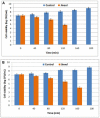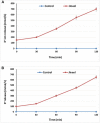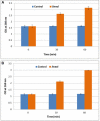Antibacterial Action of Jineol Isolated from Scolopendra subspinipes mutilans against Selected Foodborne Pathogens
- PMID: 28400770
- PMCID: PMC5368267
- DOI: 10.3389/fmicb.2017.00552
Antibacterial Action of Jineol Isolated from Scolopendra subspinipes mutilans against Selected Foodborne Pathogens
Abstract
This study was undertaken to assess the antibacterial potential of 3,8-dihydroxyquinoline (jineol) isolated from Scolopendra subspinipes mutilans against selected foodborne pathogens Escherichia coli O157:H7 and Staphylococcus aureus KCTC-1621. Jineol at the tested concentration (50 μL; corresponding to 250 μg/disk) exhibited significant antibacterial effects as a diameter of inhibition zones (11.6-13.6 mm), along with minimum inhibitory concentration (MIC) and minimum bactericidal concentration values found in the range of (62.5-125 μg/mL) and (125-250 μg/mL), respectively. Jineol also exhibited significant antibacterial effects as confirmed by the reduction in bacterial cell viabilities, increasing release of potassium (K+) ions (650 and 700 mmole/L) and 260 nm materials (optical density: 2.98-3.12) against both the tested pathogens, E. coli O157:H7 and S. aureus KCTC-1621, respectively. Moreover, changes in the cell wall morphology of E. coli O157:H7 and S. aureus KCTC-1621 cells treated with jineol at MIC further confirmed its inhibitory potential against the tested pathogens, suggesting its role as an effective antimicrobial to control foodborne pathogens.
Keywords: antimicrobial effect; foodbrone pathogens; jineol; scanning electron microscopy.
Figures





Similar articles
-
Efficacy of (+)-Lariciresinol to Control Bacterial Growth of Staphylococcus aureus and Escherichia coli O157:H7.Front Microbiol. 2017 May 3;8:804. doi: 10.3389/fmicb.2017.00804. eCollection 2017. Front Microbiol. 2017. PMID: 28515721 Free PMC article.
-
Antibacterial Activities of Wasabi against Escherichia coli O157:H7 and Staphylococcus aureus.Front Microbiol. 2016 Sep 21;7:1403. doi: 10.3389/fmicb.2016.01403. eCollection 2016. Front Microbiol. 2016. PMID: 27708622 Free PMC article.
-
Characterization and Antibacterial Potential of Lactic Acid Bacterium Pediococcus pentosaceus 4I1 Isolated from Freshwater Fish Zacco koreanus.Front Microbiol. 2016 Dec 20;7:2037. doi: 10.3389/fmicb.2016.02037. eCollection 2016. Front Microbiol. 2016. PMID: 28066360 Free PMC article.
-
Inhibition of melanogenesis by jineol from Scolopendra subspinipes mutilans via MAP-Kinase mediated MITF downregulation and the proteasomal degradation of tyrosinase.Sci Rep. 2017 Apr 10;7:45858. doi: 10.1038/srep45858. Sci Rep. 2017. PMID: 28393917 Free PMC article.
-
Antibacterial Properties of Endophytic Bacteria Isolated from a Fern Species Equisetum arvense L. Against Foodborne Pathogenic Bacteria Staphylococcus aureus and Escherichia coli O157:H7.Foodborne Pathog Dis. 2017 Jan;14(1):50-58. doi: 10.1089/fpd.2016.2192. Epub 2016 Oct 18. Foodborne Pathog Dis. 2017. PMID: 27754712
Cited by
-
Biologically active metabolite(s) from haemolymph of red-headed centipede Scolopendra subspinipes possess broad spectrum antibacterial activity.AMB Express. 2019 Jun 28;9(1):95. doi: 10.1186/s13568-019-0816-3. AMB Express. 2019. PMID: 31254123 Free PMC article.
-
Therapeutic Potential of Scolopendra subspinipes: A Comprehensive Scoping Review of Its Bioactive Compounds, Preclinical Pharmacology, and Clinical Applications.Toxins (Basel). 2025 May 5;17(5):229. doi: 10.3390/toxins17050229. Toxins (Basel). 2025. PMID: 40423312 Free PMC article.
References
-
- Alwash M. S., Ibrahim N., Ahmad W. Y. (2013). Identification and mode of action of antibacterial components from Melastoma malabathricum Linn leaves. Am. J. Infect. Dis. 9 46–58. 10.3844/ajidsp.2013.46.58 - DOI
-
- Al-Zorekya N. S., Al-Taher A. Y. (2015). Antibacterial activity of spathe from Phoenix dactylifera L. against some food-borne pathogens. Ind. Crops Prod. 65 241–246. 10.1016/j.indcrop.2014.12.014 - DOI
-
- Bajpai V. K., Sharma A., Baek K. H. (2013). Antibacterial mode of action of Cudrania tricuspidata fruit essential oil, affecting membrane permeability and surface characteristics of food-borne pathogens. Food Control 32 582–590. 10.1016/j.foodcont.2013.01.032 - DOI
LinkOut - more resources
Full Text Sources
Other Literature Sources
Medical

